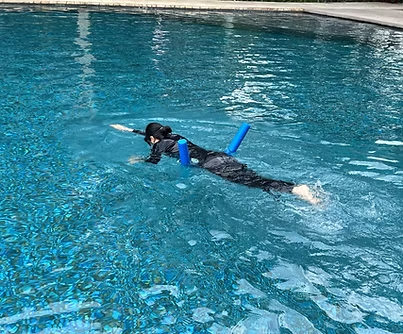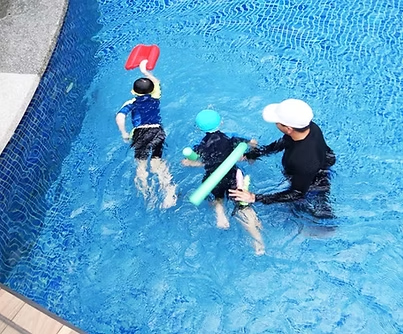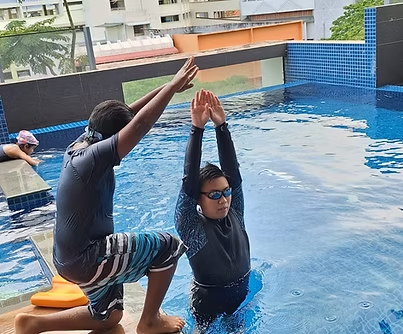
This course is designed for beginners in Penguin swim instruction, covering the essential foundations of teaching swimming. It includes basic water safety, introductory swim techniques, and effective teaching methods. Additionally, the course emphasizes strong communication skills and creating a safe, engaging learning environment for students.

This level builds on Level 1, exploring advanced swimming techniques, detailed lesson planning, and specialized teaching strategies for various age groups. It also emphasizes assessing student progress and managing more challenging learning situations.

This course is designed specifically for teaching swimming to adults, focusing on adult learning principles, effective techniques, and strategies to overcome common challenges. It acknowledges that adults have unique fears, motivations, and physical abilities compared to children, ensuring a tailored and supportive learning experience.

This course specializes in teaching swimming to infants and toddlers, covering essential safety measures, age-appropriate techniques, and strategies to make learning fun and engaging. It also includes guidance on involving parents or guardians in the learning process.

This first aid and emergency response course provides training in Cardiopulmonary Resuscitation (CPR) and the use of an Automated External Defibrillator (AED). It equips participants with essential skills to handle emergencies effectively, especially in aquatic environments.

This course equips aspiring swim instructors with the essential skills, knowledge, and techniques needed to teach swimming effectively across various age groups and skill levels. Grounded in Penguin Swim School’s unique teaching philosophy, it blends theoretical learning with hands-on practical experience.
- Cater to your needs
- Preferred location and time
- Match you to the right coach and while we monitor the coach's performance.
- Zero extra fees paid by client for outside referral. Transparency.
- Blacklist any coaches that's being banned by Sports Singapore or without proper license to ensure your safety.
Select the course that suits your needs and schedule from our range of swimming instructor courses.
Complete the payment for your selected course through our secure online payment portal.
Once you have registered for the course, our team will reach out to you to confirm your enrollment.
Upon completing the course, you’ll have the chance to interview for a part-time coaching position with our affiliated swim school. Apply your newly acquired skills and begin your journey as a swimming instructor.
Swimming Fundamentals
- Introduction to basic swimming strokes and techniques, including breaststroke and freestyle
- Strategies for teaching swimming fundamentals to different age groups and skill levels
- Best practices for creating a positive learning environment
Lesson Planning and Execution
- Overview of lesson planning strategies
- Developing lesson plans that cater to different learning styles and abilities
- Providing feedback and progress reports to swimmers and parents.
Breaststroke Fundamentals
Introduction to breaststroke technique and body position
Common mistakes and how to correct them
Strategies for teaching breaststroke to different age groups and skill levels
(6-10x attachments & assessment)
Upon successfully completing the classroom and pool sessions, participants must complete ten supervised attachments under the guidance of a mentor and pass an assessment.
Water Familiarization and Safety
- Building confidence and comfort in the water
- Safe entry and exit techniques
- Basic water survival skills
Breaststroke Fundamentals
- Introduction to breaststroke technique and body position
- Common mistakes and how to correct them
- Strategies for teaching breaststroke to different age groups and skill levels
Freestyle Fundamentals
- Introduction to freestyle technique and body position
- Common mistakes and how to correct them
- Strategies for teaching freestyle to different age groups and skill levels
Teaching Strategies and Techniques
- Effective communication and demonstration skills
- Building rapport and engaging with swimmers
- Providing feedback and progress reports to swimmers and parents
1. Cardiac Emergency Response Essentials
Participants will learn the essential principles of responding to cardiac emergencies, including recognizing warning signs, understanding the urgency of rapid intervention, and becoming familiar with legal considerations like Good Samaritan laws. This foundational knowledge prepares them for effective action in critical situations.
2. Life-Saving Techniques: CPR and AED Usage
Participants will engage in hands-on training to master essential life-saving techniques. They will learn to assess scene safety, check for responsiveness, activate emergency medical services (EMS), and perform high-quality CPR on adults, children, and infants. This section also covers the proper use of automated external defibrillators (AEDs), including component identification, pad placement, and safe operation. By developing these critical skills, participants will be equipped to respond confidently and effectively in real-life cardiac emergencies.
What’s next?
(6-10x attachments & assessment)
Upon successfully completing the classroom and pool sessions, participants must complete ten supervised attachments under the guidance of a mentor and pass an assessment.
Participants will have developed a strong foundation in swimming instruction, enabling them to design and deliver effective lessons for swimmers of all skill levels. Additionally, they will have the opportunity to join our affiliated swim school as a part-time coach.

